Two very important movements took place during













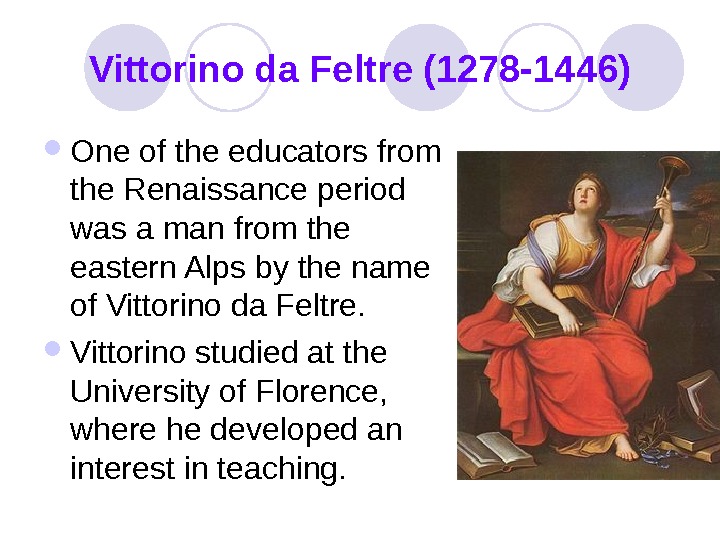
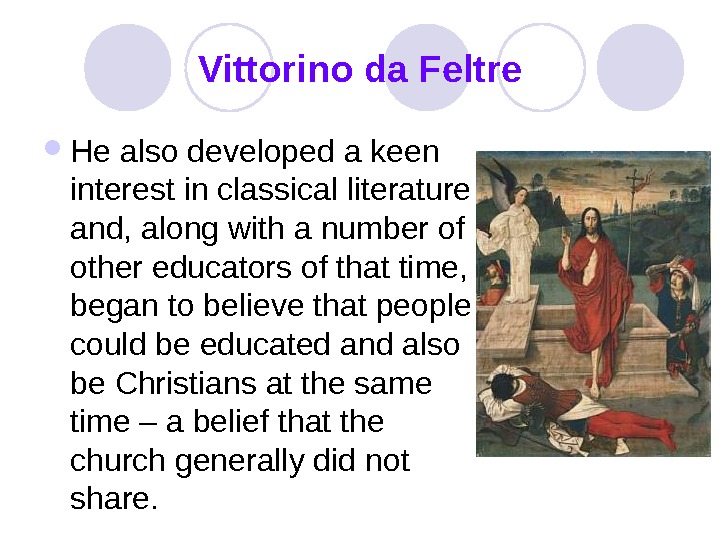















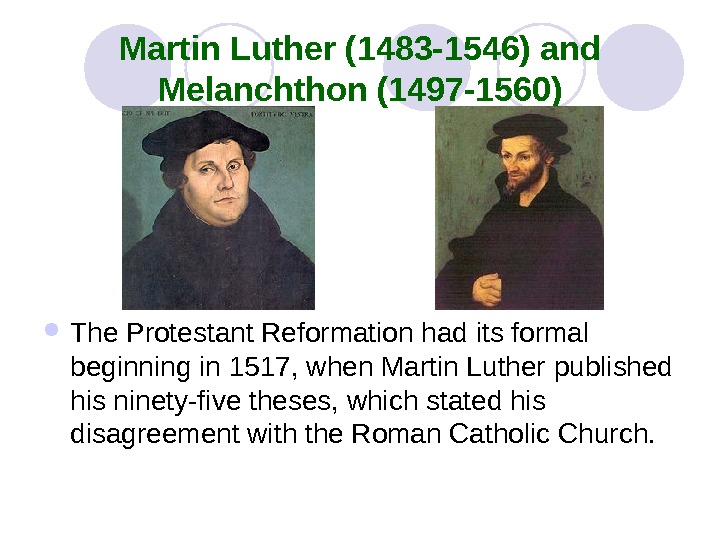


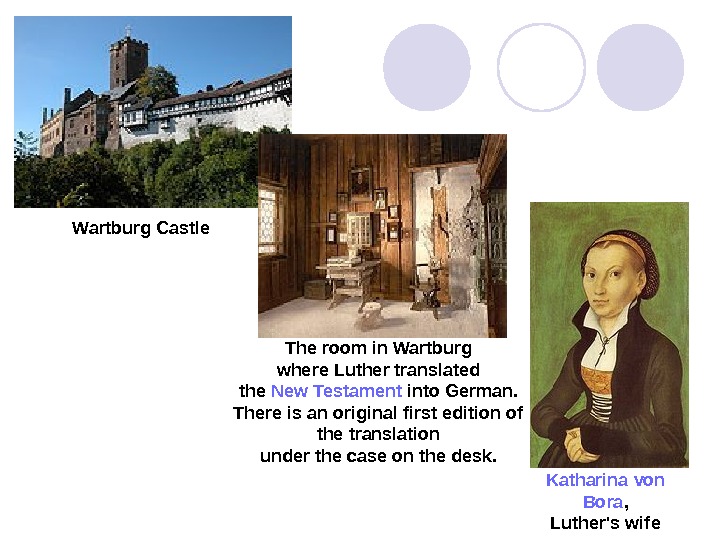












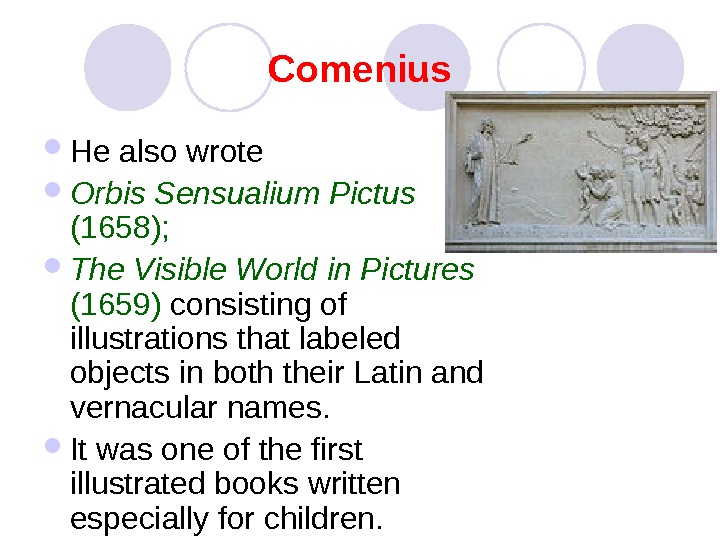






4._education_in_transition_1300_-_1700.ppt
- Размер: 2.1 Mегабайта
- Количество слайдов: 52
Описание презентации Two very important movements took place during по слайдам



 Two very important movements took place during the transition period of 1300 -1700 — the Renaissance and the Reformation.
Two very important movements took place during the transition period of 1300 -1700 — the Renaissance and the Reformation.
 The Renaissance , or rebirth of learning, began in Europe in the 14 th century and reached its height in the 15 th century. Scholars became more interested in the humanist features—that is, the secular or worldly rather than the religious aspects— of the Greek and Latin classics. Humanist educators found their models of literary style in the classics.
The Renaissance , or rebirth of learning, began in Europe in the 14 th century and reached its height in the 15 th century. Scholars became more interested in the humanist features—that is, the secular or worldly rather than the religious aspects— of the Greek and Latin classics. Humanist educators found their models of literary style in the classics.
 The Renaissance represented the protest of individuals against the dogmatic authority the church exerted over their social and intellectual life. The Renaissance started in Italy (around 1130), when humans reacquired the spirit of free inquiry that had prevailed in ancient Greece. The Renaissance was a particularly powerful force in Italy , most notably in art, literature, and architecture. The Renaissance slowly spread through Europe, resulting in a general revival of classical learning, called humanism.
The Renaissance represented the protest of individuals against the dogmatic authority the church exerted over their social and intellectual life. The Renaissance started in Italy (around 1130), when humans reacquired the spirit of free inquiry that had prevailed in ancient Greece. The Renaissance was a particularly powerful force in Italy , most notably in art, literature, and architecture. The Renaissance slowly spread through Europe, resulting in a general revival of classical learning, called humanism.
 The Renaissance Humanist educators designed teaching methods to prepare well-rounded, liberally educated persons. Dutch humanist Desiderius Erasmus was particularly influential.
The Renaissance Humanist educators designed teaching methods to prepare well-rounded, liberally educated persons. Dutch humanist Desiderius Erasmus was particularly influential.
 Erasmus (1466 -1536) was one of the most famous humanist educators, and two of his books, The Right Method of Instruction and The Liberal Education of Boys , formed a humanistic theory of education.
Erasmus (1466 -1536) was one of the most famous humanist educators, and two of his books, The Right Method of Instruction and The Liberal Education of Boys , formed a humanistic theory of education.
 The second movement, the Reformation , represented a reaction against certain beliefs of the Roman Catholic Church, particularly those that discouraged learning and that, in consequence, kept lay people in ignorance.
The second movement, the Reformation , represented a reaction against certain beliefs of the Roman Catholic Church, particularly those that discouraged learning and that, in consequence, kept lay people in ignorance.
 The Renaissance The common people were generally oppressed by wealthy landowners and royalty during the eleventh and twelfth centuries. In fact, the common people were thought to be unworthy of education and to exist primarily to serve landed gentry and royalty.
The Renaissance The common people were generally oppressed by wealthy landowners and royalty during the eleventh and twelfth centuries. In fact, the common people were thought to be unworthy of education and to exist primarily to serve landed gentry and royalty.
 The Renaissance represented a rebellion on the part of the common people against the suppression they experienced from both the church and the wealthy who controlled their lives. At that time masses of common people developed a spirit of inquiry and demanded a better life.
The Renaissance represented a rebellion on the part of the common people against the suppression they experienced from both the church and the wealthy who controlled their lives. At that time masses of common people developed a spirit of inquiry and demanded a better life.

 Vittorino da Feltre (1278 -1446) One of the educators from the Renaissance period was a man from the eastern Alps by the name of Vittorino da Feltre. Vittorino studied at the University of Florence, where he developed an interest in teaching.
Vittorino da Feltre (1278 -1446) One of the educators from the Renaissance period was a man from the eastern Alps by the name of Vittorino da Feltre. Vittorino studied at the University of Florence, where he developed an interest in teaching.
 Vittorino da Feltre He also developed a keen interest in classical literature and, along with a number of other educators of that time, began to believe that people could be educated and also be Christians at the same time – a belief that the church generally did not share.
Vittorino da Feltre He also developed a keen interest in classical literature and, along with a number of other educators of that time, began to believe that people could be educated and also be Christians at the same time – a belief that the church generally did not share.
 Vittorino da Feltre Vittorino established several schools, taught in a variety of others, and generally helped to advance the development of education during his lifetime. He believed that education was an important end in itself and thereby helped to rekindle an interest in the value of human knowledge during the Renaissance.
Vittorino da Feltre Vittorino established several schools, taught in a variety of others, and generally helped to advance the development of education during his lifetime. He believed that education was an important end in itself and thereby helped to rekindle an interest in the value of human knowledge during the Renaissance.
 Erasmus (1466 -1536) Erasmus has a good deal of educational insight. concerning the aims of education, he wrote:
Erasmus (1466 -1536) Erasmus has a good deal of educational insight. concerning the aims of education, he wrote:
 Erasmus The duty of instructing the young includes several elements, the first and also the chief of which is that the tender mind of the child should be instructed in piety; the second , that he love and learn the liberal arts; the third , that he be taught tact in the conduct of social life; and the fourth , that from his earliest age he accustom himself to good behavior, based on moral principles.
Erasmus The duty of instructing the young includes several elements, the first and also the chief of which is that the tender mind of the child should be instructed in piety; the second , that he love and learn the liberal arts; the third , that he be taught tact in the conduct of social life; and the fourth , that from his earliest age he accustom himself to good behavior, based on moral principles.
 Erasmus believed that understanding and conversing about the meaning of literature was more important than memorizing it, as had been required at many of the medieval religious schools. He advised teachers to study such fields as archaeology, astronomy, mythology, history, and Scripture.
Erasmus believed that understanding and conversing about the meaning of literature was more important than memorizing it, as had been required at many of the medieval religious schools. He advised teachers to study such fields as archaeology, astronomy, mythology, history, and Scripture.
 The Renaissance The invention of the printing press in the mid-15 th century made books more widely available and increased literacy rates. But school attendance did not increase greatly during the Renaissance. Elementary schools educated middle-class children while lower-class children received little, if any, formal schooling. Children of the nobility and upper classes attended humanist secondary schools.
The Renaissance The invention of the printing press in the mid-15 th century made books more widely available and increased literacy rates. But school attendance did not increase greatly during the Renaissance. Elementary schools educated middle-class children while lower-class children received little, if any, formal schooling. Children of the nobility and upper classes attended humanist secondary schools.

 The Renaissance Educational opportunities for women improved slightly during the Renaissance, especially for the upper classes. Some girls from wealthy families attended schools of the royal court or received private lessons at home. The curriculum studied by young women was still based on the belief that only certain subjects, such as art, music, needlework, dancing, and poetry , were suited for females. For working-class girls, especially rural peasants, education was still limited to training in household duties such as cooking and sewing.
The Renaissance Educational opportunities for women improved slightly during the Renaissance, especially for the upper classes. Some girls from wealthy families attended schools of the royal court or received private lessons at home. The curriculum studied by young women was still based on the belief that only certain subjects, such as art, music, needlework, dancing, and poetry , were suited for females. For working-class girls, especially rural peasants, education was still limited to training in household duties such as cooking and sewing.
 The Reformation It is difficult for people today to imagine the extent to which the Roman Catholic Church dominated the lives of the common people through most of what we think of as modern people during the fifteenth and sixteenth centuries.
The Reformation It is difficult for people today to imagine the extent to which the Roman Catholic Church dominated the lives of the common people through most of what we think of as modern people during the fifteenth and sixteenth centuries.

 The Roman Catholic Church and the Pope had an enormous amount of influence over European royalty during this time. In fact, some historians suggest that the Pope and other officials of the Roman Catholic Church were in some ways more powerful than many individual kings and queens.
The Roman Catholic Church and the Pope had an enormous amount of influence over European royalty during this time. In fact, some historians suggest that the Pope and other officials of the Roman Catholic Church were in some ways more powerful than many individual kings and queens.
 After all, the Roman Catholic Church could and frequently did claim that unless members of royalty abided by its rules, they were destined to spend eternity in hell – an extremely frightening prospect for any human being. Consequently, it is understandable that the church came to be a powerful influence throughout most of Europe.
After all, the Roman Catholic Church could and frequently did claim that unless members of royalty abided by its rules, they were destined to spend eternity in hell – an extremely frightening prospect for any human being. Consequently, it is understandable that the church came to be a powerful influence throughout most of Europe.
 The Reformation The religious Reformation of the 16 th century marked a decline in the authority of the Catholic Church and contributed to the emergence of the middle classes in Europe. Protestant religious reformers, such as John Calvin , Martin Luther, and Huldreich Zwingli, rejected the authority of the Catholic pope and created reformed Christian, or Protestant, churches.
The Reformation The religious Reformation of the 16 th century marked a decline in the authority of the Catholic Church and contributed to the emergence of the middle classes in Europe. Protestant religious reformers, such as John Calvin , Martin Luther, and Huldreich Zwingli, rejected the authority of the Catholic pope and created reformed Christian, or Protestant, churches.
 The Reformation In their ardent determination to instruct followers to read the Bible in their native language, reformers extended literacy to the masses. They established vernacular primary schools that offered a basic curriculum of reading, writing, arithmetic, and religion for children in their own language. Vernacular schools in England, for example, used English to teach their pupils.
The Reformation In their ardent determination to instruct followers to read the Bible in their native language, reformers extended literacy to the masses. They established vernacular primary schools that offered a basic curriculum of reading, writing, arithmetic, and religion for children in their own language. Vernacular schools in England, for example, used English to teach their pupils.
 The Reformation As they argued with each other and with the Roman Catholics on religious matters, Protestant educators wrote catechisms— primary books that summarized their religious doctrine—in a question and answer format.
The Reformation As they argued with each other and with the Roman Catholics on religious matters, Protestant educators wrote catechisms— primary books that summarized their religious doctrine—in a question and answer format.
 The Reformation While the vernacular schools educated both boys and girls at the primary level, upper-class boys attended preparatory and secondary schools that continued to emphasize Latin and Greek. The gymnasium in Germany, the Latin grammar school in England, and the lycee in France were preparatory schools that taught young men the classical languages of Latin and Greek required to enter universities.
The Reformation While the vernacular schools educated both boys and girls at the primary level, upper-class boys attended preparatory and secondary schools that continued to emphasize Latin and Greek. The gymnasium in Germany, the Latin grammar school in England, and the lycee in France were preparatory schools that taught young men the classical languages of Latin and Greek required to enter universities.
 Martin Luther (1483 -1546) and Melanchthon (1497 -1560) The Protestant Reformation had its formal beginning in 1517, when Martin Luther published his ninety-five theses, which stated his disagreement with the Roman Catholic Church.
Martin Luther (1483 -1546) and Melanchthon (1497 -1560) The Protestant Reformation had its formal beginning in 1517, when Martin Luther published his ninety-five theses, which stated his disagreement with the Roman Catholic Church.
 Luther’s mother, Margarethe One of Luther’s monastic cells First edition of Exsurge Domine.
Luther’s mother, Margarethe One of Luther’s monastic cells First edition of Exsurge Domine.
 Martin Luther believed the state, family, and school , along with the church, were leaders of the Reformation. Since the family shaped children’s character, Luther encouraged parents to teach their children reading and religion. Each family should pray together, read the Bible, study the catechism, and practice a useful trade.
Martin Luther believed the state, family, and school , along with the church, were leaders of the Reformation. Since the family shaped children’s character, Luther encouraged parents to teach their children reading and religion. Each family should pray together, read the Bible, study the catechism, and practice a useful trade.
 Wartburg Castle The room in Wartburg where Luther translated the New Testament into German. There is an original first edition of the translation under the case on the desk. Katharina von Bora , Luther’s wife
Wartburg Castle The room in Wartburg where Luther translated the New Testament into German. There is an original first edition of the translation under the case on the desk. Katharina von Bora , Luther’s wife
 The house where Luther died. His tombstone in the Castle Church in Wittenberg.
The house where Luther died. His tombstone in the Castle Church in Wittenberg.
 Martin Luther One of these disagreements held great implications for the importance of formal education. The church believed that it was not desirable for each person to read and interpret the Bible for himself or herself; rather, the church would pass on the “correct” interpretation to the laity. Luther felt not only that the church had itself misinterpreted the Bible, but also that people were intended to read and interpret the Bible for themselves.
Martin Luther One of these disagreements held great implications for the importance of formal education. The church believed that it was not desirable for each person to read and interpret the Bible for himself or herself; rather, the church would pass on the “correct” interpretation to the laity. Luther felt not only that the church had itself misinterpreted the Bible, but also that people were intended to read and interpret the Bible for themselves.
 Martin Luther If one accepted the church’s position on this matter, formal education remained unimportant. If one accepted Luther’s position, however, education became necessary for all people so that they might individually read and interpret the Bible. In a sense, education became important as a way of obtaining salvation.
Martin Luther If one accepted the church’s position on this matter, formal education remained unimportant. If one accepted Luther’s position, however, education became necessary for all people so that they might individually read and interpret the Bible. In a sense, education became important as a way of obtaining salvation.
 Melanchthon It is understandable that Luther and his educational coworker, Melanchthon, soon came to stress universal elementary education. Melanchthon’s most important educational writing was Visitation Articles (1528), in which he set forth his recommendations for schools. Luther and Melanchthon felt that education should be provided for all, regardless of class, and should be compulsory for both sexes.
Melanchthon It is understandable that Luther and his educational coworker, Melanchthon, soon came to stress universal elementary education. Melanchthon’s most important educational writing was Visitation Articles (1528), in which he set forth his recommendations for schools. Luther and Melanchthon felt that education should be provided for all, regardless of class, and should be compulsory for both sexes.
 Luther and Melanchthon They also believed that it should be state-controlled, state-supported, and centered on classical languages, grammar, mathematics, science, history, music, and physical education. Luther’s argument for increased governmental support for education has a familiar twentieth-century ring:
Luther and Melanchthon They also believed that it should be state-controlled, state-supported, and centered on classical languages, grammar, mathematics, science, history, music, and physical education. Luther’s argument for increased governmental support for education has a familiar twentieth-century ring:
 Luther and Melanchthon Each city is subjected to great expense every year for the construction of roads, fortifying its ramparts, and for buying arms and equipping soldiers. Why should it not spend an equal sum for the support of one or two schoolmasters? The prosperity of a city does not depend solely on its natural riches, on the solidity of its walls, on the elegance of its mansions, and on the abundance of arms in its arsenals; but the safety and strength of a city reside above all in a good education, which furnishes it with instructed, reasonable, honorable, and well-trained citizens.
Luther and Melanchthon Each city is subjected to great expense every year for the construction of roads, fortifying its ramparts, and for buying arms and equipping soldiers. Why should it not spend an equal sum for the support of one or two schoolmasters? The prosperity of a city does not depend solely on its natural riches, on the solidity of its walls, on the elegance of its mansions, and on the abundance of arms in its arsenals; but the safety and strength of a city reside above all in a good education, which furnishes it with instructed, reasonable, honorable, and well-trained citizens.
 Luther and Melanchthon Luther believed that government should assist schools in educating literate, productive, and religious citizens. Luther’s colleague, German religious reformer Melanchthon, wrote the school code for the German region of Württemberg, which became a model for other regions of Germany and influenced education throughout Europe. According to this code, the government was responsible for supervising schools and licensing teachers.
Luther and Melanchthon Luther believed that government should assist schools in educating literate, productive, and religious citizens. Luther’s colleague, German religious reformer Melanchthon, wrote the school code for the German region of Württemberg, which became a model for other regions of Germany and influenced education throughout Europe. According to this code, the government was responsible for supervising schools and licensing teachers.
 The Reformation The Protestant reformers retained the dual-class school system that had developed in the Renaissance. Vernacular schools provided primary instruction for the lower classes, and the various classical humanist and Latin grammar schools prepared upper-class males for higher education.
The Reformation The Protestant reformers retained the dual-class school system that had developed in the Renaissance. Vernacular schools provided primary instruction for the lower classes, and the various classical humanist and Latin grammar schools prepared upper-class males for higher education.

 EDUCATIONAL THEORY IN THE 17 TH CENTURY Educators of the 17 th century developed new ways of thinking about education. Czech education reformer Jan Komensky, known as Comenius, was particularly influential. John Amos Comenius (1592– 1670)
EDUCATIONAL THEORY IN THE 17 TH CENTURY Educators of the 17 th century developed new ways of thinking about education. Czech education reformer Jan Komensky, known as Comenius, was particularly influential. John Amos Comenius (1592– 1670)
 Comenius A bishop of the Moravian Church, Comenius escaped religious persecution by taking refuge in Poland, Hungary, Sweden, and The Netherlands. He created a new educational philosophy called Pansophism, or universal knowledge, designed to bring about worldwide understanding and peace.
Comenius A bishop of the Moravian Church, Comenius escaped religious persecution by taking refuge in Poland, Hungary, Sweden, and The Netherlands. He created a new educational philosophy called Pansophism, or universal knowledge, designed to bring about worldwide understanding and peace.
 Comenius advised teachers to use children’s senses rather than memorization in instruction. To make learning interesting for children, he wrote The Gate of Tongues Unlocked (1631) , a book for teaching Latin in the student’s own language.
Comenius advised teachers to use children’s senses rather than memorization in instruction. To make learning interesting for children, he wrote The Gate of Tongues Unlocked (1631) , a book for teaching Latin in the student’s own language.
 Comenius He also wrote Orbis Sensualium Pictus (1658); The Visible World in Pictures (1659) consisting of illustrations that labeled objects in both their Latin and vernacular names. It was one of the first illustrated books written especially for children.
Comenius He also wrote Orbis Sensualium Pictus (1658); The Visible World in Pictures (1659) consisting of illustrations that labeled objects in both their Latin and vernacular names. It was one of the first illustrated books written especially for children.
 Locke The work of English philosopher John Locke influenced education in Britain and North America. Locke examined how people acquire ideas in An Essay Concerning Human Understanding (1690). He asserted that at birth the human mind is a blank slate, or tabula rasa , and empty of ideas. We acquire knowledge, he argued, from the information about the objects in the world that our senses bring to us. We begin with simple ideas and then combine them into more complex ones. John Locke (1632 -1704)
Locke The work of English philosopher John Locke influenced education in Britain and North America. Locke examined how people acquire ideas in An Essay Concerning Human Understanding (1690). He asserted that at birth the human mind is a blank slate, or tabula rasa , and empty of ideas. We acquire knowledge, he argued, from the information about the objects in the world that our senses bring to us. We begin with simple ideas and then combine them into more complex ones. John Locke (1632 -1704)
 Locke believed that individuals acquire knowledge most easily when they first consider simple ideas and then gradually combine them into more complex ones. In Some Thoughts Concerning Education (1697), Locke recommended practical learning to prepare people to manage their social, economic, and political affairs efficiently.
Locke believed that individuals acquire knowledge most easily when they first consider simple ideas and then gradually combine them into more complex ones. In Some Thoughts Concerning Education (1697), Locke recommended practical learning to prepare people to manage their social, economic, and political affairs efficiently.
 EDUCATIONAL THEORY IN THE 17 TH CENTURY He believed that a sound education began in early childhood and insisted that the teaching of reading, writing, and arithmetic be gradual and cumulative. Locke’s curriculum included conversational learning of foreign languages, especially French, mathematics, history, physical education, and games.
EDUCATIONAL THEORY IN THE 17 TH CENTURY He believed that a sound education began in early childhood and insisted that the teaching of reading, writing, and arithmetic be gradual and cumulative. Locke’s curriculum included conversational learning of foreign languages, especially French, mathematics, history, physical education, and games.


 Thank you for your attention!
Thank you for your attention!

